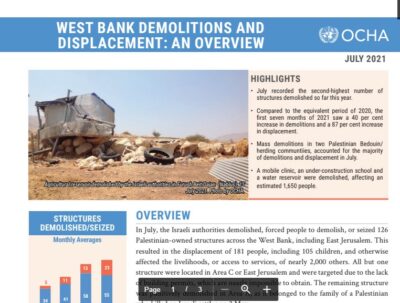Report by The United Nations Office for the Coordination of Humanitarian Affairs (OCHA): West Bank Demolitions and Displacement Report
Highlights
- July recorded the second-highest number of structures demolished so far this year.
- Compared to the equivalent period of 2020, the first seven months of 2021 saw a 40 % increase in demolitions and a 87 % increase in displacement.
- Mass demolitions in two Palestinian Bedouin/herding communities, accounted for the majority
of demolitions and displacement in July.
- A mobile clinic, an under-construction school and a water reservoir were demolished, affecting an estimated 1,650 people.
Overview
- In July, the Israeli authorities demolished, forced people to demolish, or seized 126 Palestinian-owned structures across the West Bank, including East Jerusalem. This resulted in the displacement of 181 people, including 105 children, and otherwise affected the livelihoods, or access to services, of nearly 2,000 others. All but one structure were located in Area C or East Jerusalem and were targeted due to the lack of building permits, which are nearly impossible to obtain. The remaining structure was punitively demolished in Area A, as it belonged to the family of a Palestinian who allegedly killed an Israeli settler on 2 May.
- The number of structures demolished or seized in July is the second highest this year, surpassed only by February (153). So far, 2021 has recorded an increase of 40 % in the number of demolitions compared with the equivalent period in 2020 and approximately the same level of destruction of donor-funded assets (161 vs. 157 structures). So far in 2021, 295 structures, or 62 % of all structures targeted
in Area C, have been seized without, or with very short, prior notice, preventing affected people from objecting in advance.
- Thirty-one of the structures demolished or seized in July had been provided as humanitarian aid. In addition, four EU-funded residential structures received stop-work orders in Khirbet Ar Rahwa (Hebron), at a value of over 9,000 euros.
- About 80 per cent of Area C demolitions and 90 per cent of people displaced were recorded in two Area C herding communities. On 14 July, 49 structures were demolished in Ras at Tin, of which at least 21 were residential structures, 16 animal shelters and 12 solar panels; 84 people were displaced, including 53 children. On 7 July, 30 structures were demolished in the Bedouin community of Humsa al Bqai’a (Tubas), displacing 42 people. This community is located in an area designated by the Israeli authorities for military training purposes and has recorded seven demolition incidents since the beginning of the year.
- The majority of people affected (an estimated 1,650 out of 1,889 people) were in three incidents, where a mobile clinic was demolished in Umm Qussa community (Hebron), an under-construction school was demolished in the Shu’fat neighbourhood of East Jerusalem, and an agricultural reservoir in was demolished Furush Beit Dajan (Nablus). In Bardalah (Tubas), the Israeli authorities demolished a livelihood structure on the basis of Military Order 1797, which provides only a 96-hour notice and very limited grounds for legally challenging a demolition.
- In East Jerusalem, the Israeli authorities demolished or forced people to demolish 21 structures, almost the same number as those demolished in June (20). Eleven of the structures were demolished by the owners following the issuance of a demolition order, bringing the total number of such demolitions carried out by the owners since the beginning of the year to 42.
Video by Silwanic
The most difficult thing is to demolish the house that we built with our own hands, but we have no choice. The occupation wants to expel us from our homes. We are steadfast in our land and homeland.”
– Muhammad Amin Abu al-Hawa

